Top 10 Online Business Models to Start Making Money

Chances are you’ve got an entrepreneurial spirit and want to create a successful online business. After all, here you are researching in your free time to make it happen.
Well, you’re in luck. It’s never been easier to find success in the digital space. All you need is a laptop, good wifi, some hard work, and a plan, and you can become your boss and work from anywhere in the world.
There are a few things to understand before we dive into the Top 10 Online Business Models. I’ve gone ahead and broken them down below.
B2B Vs. B2C
Chances are in your research, you’ve come across the phrases B2B & B2C. This refers to business-to-business or business-to-consumer.
In a B2B or business-to-business model, one professional enterprise offers a service to another. Imagine a company like Quickbooks, that handles billing and payroll. Quickbooks is a business tool and therefore goes after other businesses. B2B deals can be harder to close but have larger average order values.
In a B2C or business-to-consumer model, a business is marketing its product to your average consumer. These offers are more readily available and offer a larger volume of sales. An example of a B2C model would be a company like Target selling lamps to regular consumers. The average order value is low but the number of people they can sell to us a lot larger.
Now that we’ve discussed the way you can sell a product let’s break down the 3 major categories online business fall into.
Categories For Online Businesses:
Products
A lot of online business models are centered around a physical product. You might think this is the opposite of what you would want in an online business as holding inventory can be expensive.
Fortunately, through dropshipping, which we discuss further below, these days you can have a store that sells a physical product and never even touch it.
Services
You will find there are many online business models centered around service. These products are sold directly to the consumer instantly. Your website can be considered a service-based product because it facilitates the transaction right there.
Service-based businesses could be anything from a website to book a plumber to a website that plans vacations. Your site is an advertisement for a service someone could fulfill physically or digitally.
Information
The majority of online businesses will fall into this category. Information. Chances are people are on the web looking for information on a particular subject.
Here you are looking for information on online businesses.
You can create an entire business around fulfilling this need. Through podcasts, guides, resources, YouTube videos, and more you have the opportunity to sell all the information you have. The internet has made so much information available that many people want resources that cut through the clutter. You can provide that to them at a cost of course.
Now that we’ve learned the types of products you can sell in the digital space I want to show you 10 examples of successful online business models most people are using today.
10 Online Business Models
Dropshipping
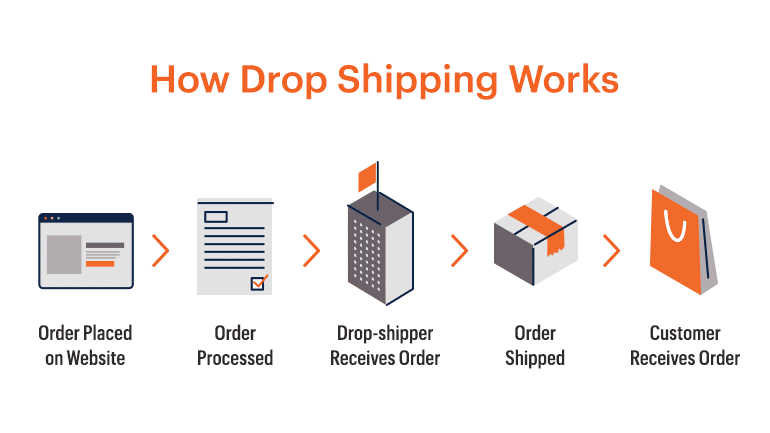
Source: Magento
According to Grandview Research, “The global dropshipping market size was valued at USD 102.2 billion in 2018 and is expected to register a CAGR of 28.8% from 2019 to 2025. ” That is an insane amount of money and makes dropshipping one of the top online business models.
Dropshipping is a model where you as the advertiser don’t hold any inventory. You facilitate the sale of an item and then a third party receives the buyer information and ships out the item on your behalf.
Pros:
- You don’t have to hold any inventory. Since the third party holds the inventory you don’t have to come out of pocket on an item that might not sell.
- You are not responsible for shipping logistics. The distributor will manage all the shipping for you which can get expensive and complicated especially if you try shipping internationally.
- You can sell thousands of products with little to no risk. Chances are the third party you work with will warehouse thousands of items for you to sell. You can have a ton of variety in your store as a result.
Cons:
- You can run into low-profit margins. Since you don’t have much overhead the third-party company will be taking a huge cut of any margins. You can expect to make less than 20% on items sold.
- You can’t control the supply chain. If customers have issues receiving their product you might be on the hook or have to field their complaints.
- You have to build a brand. If you want to make money by selling physical products, you will have to craft a reputable e-commerce store. This means building a site that ranks in the search engine results pages. You will need to invest in content, creative, web design, and hosting.
Get Started With Dropshipping: Importify
Importify is a tool that will help automate your dropshipping business by linking your wholesaler’s feed into your site.
Affiliate Marketing
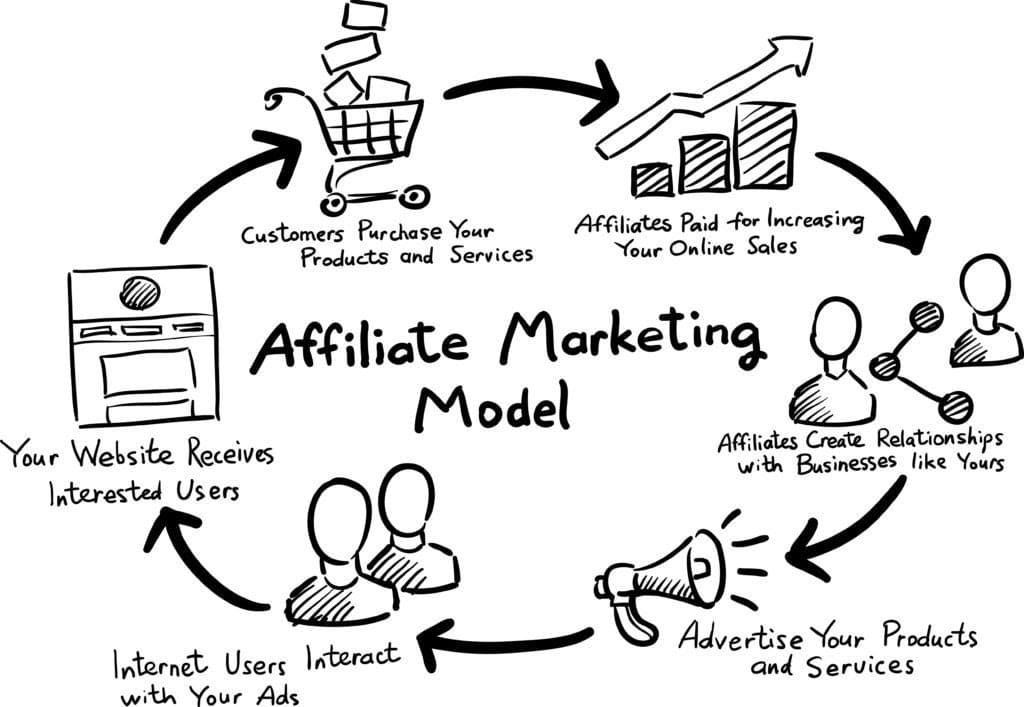
Source: Shopify
By far the most simple way to create a successful online business is through affiliate marketing. You can read my entire guide to affiliate marketing for an in-depth breakdown.
To put it plainly affiliate marketing is similar to dropshipping except the distributor of the product might not sell a physical product. The way affiliate marketing works is that a company trying to sell a product will kick back a commission to you the marketer of that product.
You’re probably familiar with influencers selling teas on their pages that are meant to make you skinny. Chances are once you click on their link and buy, that influencer just made a percentage of the sale.
There are a few different ways affiliate marketers get paid. Sometimes it is a flat rate for every sale. Sometimes it’s a percentage of a sale. But what you want is a program that pays you for the lifetime of the customer. Initially, the amount might be small but you will have that passive income as long as the customer uses the service.
Pros:
- Tons of offers in different niches. One of the easiest ways to drive free traffic to your site is to create a niche site and have it rank. By having offers in a variety of niches affiliate marketing allows you to promote offers that seamlessly tie into your brand and your content.
- You can do it part-time. Affiliate marketing can always be a side hustle for you until you ramp up to doing it full time. When I was starting I only did affiliate marketing part-time until it turned into a major revenue stream for me.
- Passive income. The beauty of affiliate marketing is that if you put a great piece of content out filled with affiliate links it could turn into a passive income stream. There are affiliate programs that payout for the whole lifetime of the customer. This means recurring revenue you can count on month after month.
Cons:
- It can be competitive. Some affiliate offers pay out hundreds of dollars for a single conversion which means this business model is filled with hungry marketers. You’ll want to join top affiliate networks to get access to the best offers. You’ll also want to conduct a ton of keyword research to make sure your content ranks organically.
- Some conversion will lose their tracking. Unfortunately tying back affiliate sales is done through cookies and codes in URLs. If someone reads your content and then converts it on a different computer or even their phone there is a chance that a sale you helped facilitate won’t get credited to you.
Get Started With Affiliate Marketing: Read my Ultimate Guide To Affiliate Marketing
In this guide, I explain everything you need to know to start making money with affiliate marketing.
Webinars

Image Source: ClickFunnels
Webinars are a great business model for driving sales in an online business. For one they are a great product to promote as a lead generation product that you sell a product at, or they can be a great actual product to sell.
To use a webinar as lead gen you would simply advertise it as education. For example, “come hear what the next big crypto will be.” Lots of people would sign up for that free event. Once you have everyone there you can sell them a product or service you are promoting.
Another way to use webinars to make money is to sell them as courses. If you’re an expert on a specific topic you can charge people to attend your webinar. Think about it as a masterclass. You can turn your webinar into an event you don’t even have to host by selling tickets to a recording of it.
Pros:
- It can be passive. Create an evergreen webinar. Sell it through a Google ranking article and let it generate revenue on its own.
- Webinars are inexpensive. You don’t need to have a home production studio to host an amazing webinar. A webcam, a mic, and a webinar hosting service are all you need to create your product.
- You upsell within your webinar. Fully monetize your webinar by selling other products while you have a captive audience. Sell them the recordings or resources you discuss in your lesson.
Cons:
- You need expertise. You will have many angry customers if you put out a webinar you have no business talking about. If you’re not an expert in a field do some serious research until you are. Putting out one bad webinar could ruin your reputation.
- You’ll need help. Even if you just getting started you’ll need at least one other person to ensure it goes off without a hitch. You’ll need someone helping with audience moderating and maybe even another person to help with tech support.
Get Started With Webinars: GoToMeeting
This platform helps facilitate your webinar and includes a page you can use to help people register for the event as well as a portal for help moderating it
Lead Generation
A lead is simply someone interested in your business, service, or product. Usually enough to fill out a form to actively request more information.
The lead generation business model is great because you don’t have to sell anything. You simply have to drive leads. Much like any affiliate business with lead generation, you’ll be given a unique link and all you have to do is get people to sign up as a lead.
What this means for you as a marker is that you’ll get paid every time someone signs up. Lucky for you convincing someone to sign up as a lead is much easier than convincing them to purchase something. The barrier to entry is much lower as they don’t have to enter any credit card information.
You can find some programs that join lead generation and affiliate marketing. In these programs, you’ll get paid a small amount for every lead and then a much larger amount if that lead ends up converting into a sale.
Pros:
- You don’t have to make a sale. Converting someone to give you their credit card information is hard with this business model you don’t have to.
- It’s scalable. Even if a company is only paying you $5 a lead if you have a site that brings in a ton of traffic that can easily scale to 1000 leads a month. Before you know it your internet business is bringing in a ton of money.
- Leads are cheap. You can acquire leads for a fairly low amount of money. Even if you were doing Google Search ads, assuming you were bidding on the correct keywords, you could still make a profit while paying for marketing efforts.
Cons:
- You might need to qualify the lead. Qualifying a lead means you’ve asked some preliminary questions that are important to the company trying to make the conversion. These questions are often about where the customer might be in their journey to purchase. For example, if a realtor told you they would pay you $50 per lead but the leads must be qualified you would have to add questions to your sign-up form like “How much money do you make.”
- You might not get paid. Sometimes bots will fill out lead gen forms or the lead will look dicey to the company you’re working with. It’s really at their discretion to pay you or not
Get Started With Lead Generation: BlueHost
BlueHost will pay you $5 per lead. If your site content and traffic aligns with this offer BlueHost is has a great lead-gen offer for you to promote.
Podcast
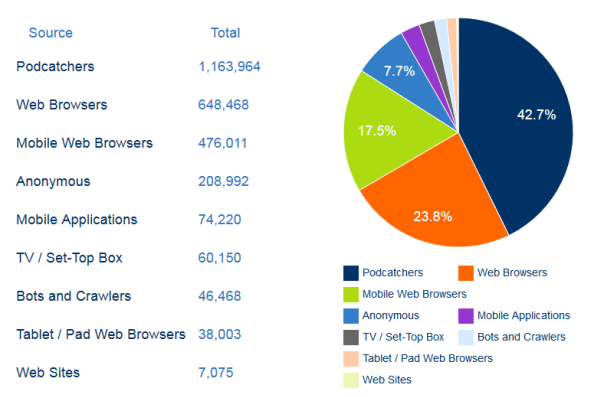
Source: Blubrry
Now before you roll your eyes I know everyone and their mom has a podcast. But not everyone knows how to make money from their podcast. According to TheBestMedia, “As an estimate, if your podcast has about 10,000 downloads per episode, you can expect to make between $500 – $900 per episode in affiliate sales.”
In case you don’t know, a podcast is essentially an hour or so long voice recording of someone discussing a certain topic.
The business model is pretty much the same across any monetized podcast. Tons of ads. You’ve probably been deeply into a podcast just to have it interrupted by an ad from the host for Spotify premium. And that ad likely gives you a code you can use for a discount. This code is how companies track sales and know how much to pay out the host.
Companies are counting on podcast listeners to be more loyal to their hosts and comfortable with the sound of their voice so they will often have the host read a message with the promotion in it for the ad to be more seamless.
Pros:
- You don’t need to be an expert. It does help to have a podcast with groundbreaking education but sometimes people just want to be entertained. Some of the most popular podcasts are just people talking about murders that happened a long time ago.
- You don’t need a schedule. Your audience will likely want an episode every week but as long as there are a lot of episodes to catch up on they won’t realize you haven’t put one out in a while.
- Podcasts have longevity. I recently listened to a podcast that was produced 6 years ago. They had ads in them that are likely still generating revenue. What I’m trying to say is the producers of that podcast are still cashing checks from it. You don’t need a website to make money online but you will still need affiliate offers.
Cons:
- Your ads might get ignored. It’s pretty simple for listeners to just fast forward over your ads which means they won’t have a chance to help make you money.
- You will need to spend time on production. This business model is a little more involved than most. While you can do it part-time creating a podcast takes a lot of time. You’ll have to record, edit, mix sound, and more.
Monetize Your Podcast with Patreon.
Patreon is a platform that allows artists or producers of great content to get paid. You can use this service to invite fans of your podcast to contribute to your production.
Apps
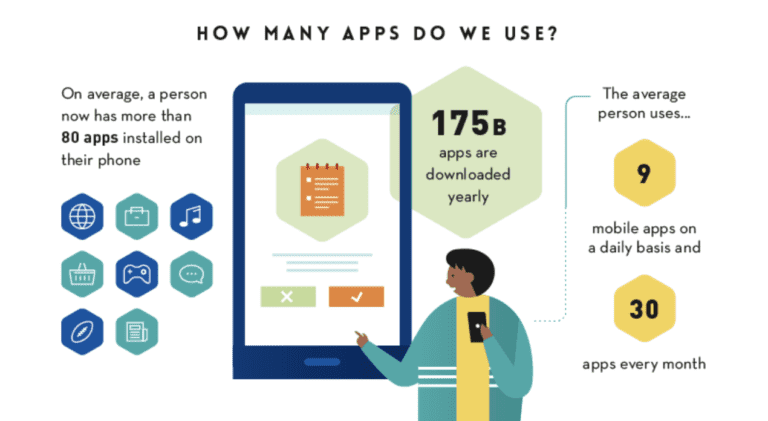
Source: Kairos Technology
Creating apps is one of the best online business models. If you create a useful app you can expect users to be willing to pay good money for it.
You have the option to either create an app from scratch or white label an app for an existing business. When you create an app for a business your app should reflect everything on their site and more. Business owners want apps created because it’s another way for them to reach their customers through push notifications and drive traffic to their business.
Apps are monetized through the price to download or through in-app subscriptions. The great thing about apps is the majority of them are on a reoccurring billing schedule so many people download it, sign up to pay and then completely forget they are in a subscription.
Pros
- Huge need. Almost every business needs an app and doesn’t have a clue on where to start. You can go door to door at small businesses in your town and find business owners looking to improve their customer experience.
- You don’t need to reinvent the wheel. You can remix existing apps into something new. If you see two simple apps and think they would be better combined you can take the best features of each of them. Assuming it has the functionality of both apps people will likely choose yours.
- Rebill. This online business model is a great opportunity for reoccurring revenue. While you have the chance to charge a one-off fee for your app download, subscriptions end up making a lot more money in the long run.
Cons
- You might need a developer. While there are some app-building drag and drop templates out there if you want to build an app that is complex you’ll need to learn to code or hire a developer.
- There are tons of apps. Your app will need to stand out in the app store as there are already thousands. Additionally, you’ll have to market your app to help it do so.
Get Started With App Building Using Thunkable
Thunkable is a drag-and-drop app builder that requires no coding experience. Chose from their thousands of templates and create an app for yourself or clients.
Digital Consulting
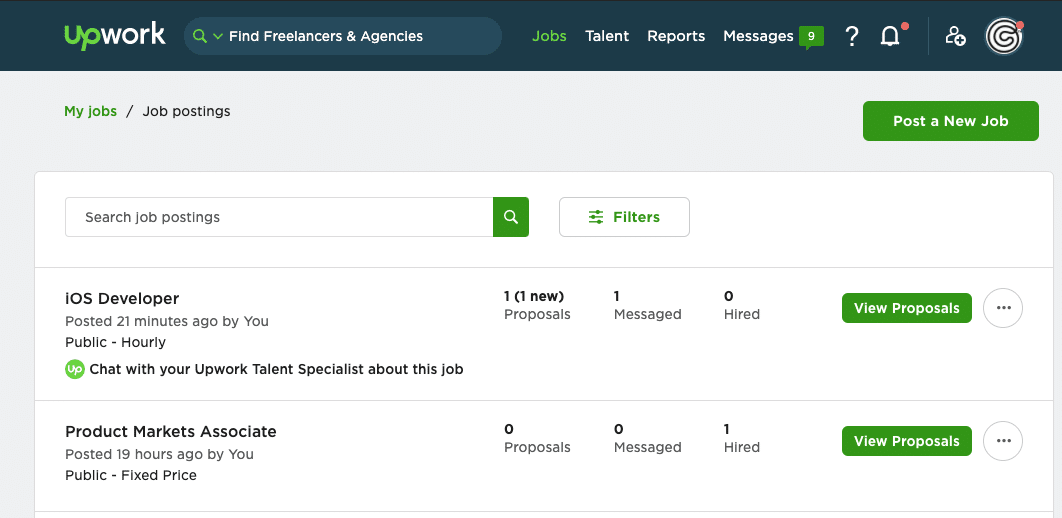
You can’t go wrong with digital consulting as a service-based business model. There is so much flexibility when it comes to digital consulting think of it as a virtual physical trainer, life coach, marketing, web development, and more.
If you are an expert on anything you can become a digital consultant. Essentially as a consultant, you’ll advise a business or a person in whatever field you have expertise in. Consultants generally do not fully integrate with a company the way an employee would. Contracts are generally at-will meaning you or the client could terminate at any point.
Pros
- Consulting is flexible. You get to pick your hours, the term of your contracts, your price point, and whatever services you want to offer.
- You can charge a premium. Companies expect consultants to come in, make a big impact and then leave. As a result, they expect to pay a lot of money for it. You get to set your rate as a consultant.
Cons
- Work can be unpredictable. In this online business model, you’ll have busy weeks and slow weeks. Sign contracts with your clients so you can count on your services to make you money.
- You don’t get benefits. As a digital consultant, you won’t get all the benefits full-time employees get like health care and days off.
Get Started With Digital Consulting Through Upwork
Upwork is a great place to start your journey as a digital consultant. Companies turn to Upwork to find freelancers so you can find a ton of job listings here. Upwork protects consultants by holding money in escrow until projects are completed.
Membership Site

Source: Wix
Did you know you can charge people just to access your site? If you have a blog that has the information you worked hard to put together you should be charging for your efforts. Membership sites can offer access to exclusive content or events as well.
A membership site generally works by having a hybrid of free content and paid content. You will still need to drive organic traffic to your site to grow interest in your paid content.
Pros
- Less effort is required. If you put out a webinar or a course, patrons will expect a super polished product in a professional package. Memberships sites can be as simple as charging people to read a blog about your life.
- You can do more volume. Membership sites are at a relatively low price point which means this online business model can do a larger volume of sales.
Cons
- You will have to generate traffic. As with most internet business models you will have to get your content to rank organically. To do this you will need to conduct keyword research and become an expert with topical authority.
You can start with created a membership site with Kajabi.
Kajabi is a popular online tool that seamlessly moves your site into a membership site by managing your billing, courses, memberships, and more.
Online Courses

Source: Zapier
Online courses are a great e-commerce business model where you sell digital downloads or access to a course. If you can put together the resources to teach a skill or educate others this is a profitable option for you.
To create a successful online course you will want to market yourself as an expert in your field. You’ll need to create a social media presence and a website in a niche that you have authority.
Online courses can be anything from just written text, to videos, downloads, worksheets, and more. The best online courses include video and a screen share element if applicable.
Pros:
- Low start-up cost. Creating an online course is one of the best service-based business models concerning cost. You just need a computer with a webcam and a site to sell your product on.
- Your education is more valuable. Producing a course lets you put together a multi-series guide for your subscribers which adds more value than just a blog.
Cons:
- Longevity. You might have to refresh your course every year or so depending on how fast your industry moves. Other online business models like an affiliate business model offer a more passive income opportunity.
- Courses take time. There is a lot more production value that goes into putting together a course. You can expect it to take a very long time filming, editing, and creating resources. As a result, you can charge a lot more for a course.
To get started creating an online course you can use Udemy
Udemy makes it easy to create a course on their platform and more importantly they help market your course to their hundreds of thousands of users.
Final Findings
I hope these ideas helped spark an idea for you that builds a successful online business. With research, passion, and expertise you can use any one or a combination of these ideas to grow your brand. Good luck and happy creating.



